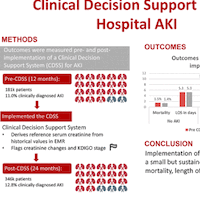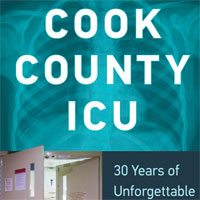
Clinical Decision Support for In-Hospital AKI
AKI carries a significant mortality and morbidity risk. Use of a clinical decision support system (CDSS) might improve outcomes. We conducted a multicenter, sequential period analysis of 528,108 patients without ESRD before... read more

Abnormal Saline and the History of Intravenous Fluids
Two new clinical trials together involving nearly 30,000 patients support previous observational evidence that the most common solution used for intravenous fluid therapy in the world is associated with kidney damage. Both... read more

Why a terminally ill young woman has changed her mind about living
o face each day, Claire Wineland undergoes hours of breathing treatments. It's a reality of living with cystic fibrosis she's come to accept. But last month, as the nebulizer hummed loudly in her La Jolla, California, hotel... read more

Early Interventions for the Prevention of Posttraumatic Stress Symptoms in Survivors of Critical Illness
Despite a paucity of high-quality clinical investigations, the preponderance of evidence to date suggests that 1) posttraumatic stress disorder among survivors of critical illness may be preventable and 2) early interventions... read more

A Randomized Trial of a Family-Support Intervention in ICUs
Family-support intervention in ICUs increased patient comfort and reduced costs. Among critically ill patients and their surrogates, a family-support intervention delivered by the interprofessional ICU team did not significantly... read more

Looking for a Better Way to Treat Hypoxia in the Emergency Department? Reach for High-Flow Nasal Cannula
High-flow nasal cannula should be considered a first-line therapy in all patients with hypoxemic respiratory failure not from cardiogenic pulmonary edema and without concomitant hypercapnia. The high flow rate of HFNC offers... read more

Do We Know Enough to Recommend Corticosteroids in ARDS?
We read with interest the evidence-based recommendations for the use of prolonged corticosteroids in early moderate to severe acute respiratory distress syndrome (ARDS) published in Critical Care Medicine by the Corticosteroid... read more

Association of the Quick Sequential (Sepsis-Related) Organ Failure Assessment (qSOFA) Score With Excess Hospital Mortality in Adults With Suspected Infection in Low- and Middle-Income Countries
In this retrospective secondary analysis of 9 diverse LMIC cohorts that included 6569 hospitalized adults with suspected infection, a qSOFA score greater than or equal to 2 was significantly associated with increased likelihood... read more

Temporal Biomarker Profiles and Their Association with ICU Acquired Delirium
While there are differences in markers (adiponectin and several brain proteins) between patients with and without delirium, the development of delirium is not preceded by a change in the biomarker profile of inflammatory... read more

The Answer My Friend is Blowin’ in your Nose – High Flow Nasal Oxygen
High flow nasal oxygen is a novel device that actively humidifies and heats air to make flows of up to 60 liters a minutes tolerable. These incredibly high flows are important, because in order to provide 100% fiO2 to patients... read more

Implementing Treatment Algorithms for the Correction of Trauma Induced Coagulopathy
The 5-year TACTIC project is a multi-component study, a main focus of which is the development of European-wide clinical trial, entitled "Implementing Treatment Algorithms for the Correction of Trauma Induced Coagulopathy... read more
Whole Blood – More than the Sum of Its Components?
This retrospective analysis was conducted in a US Military population across 6 combat hospitals in Iraq and Afghanistan between January 2004 and October 2007. Patient's transfused at least 1 unit RBCs met inclusion criteria... read more

A 10-year review of total hospital onset ICU bloodstream infections at an Academic Medical Center
Across all ICUs, the rates of primary BSIs progressively fell from 2.11/1000 patient days in FY05 to 0.32/1000 patient days in FY14; an 85.0% decrease (P<0.0001). Secondary BSIs also progressively decreased from 3.56/1000... read more

Cook County ICU: 30 Years of Unforgettable Patients and Odd Cases
An inside look at one of the nation's most famous public hospitals, Cook County, as seen through the eyes of its longtime Director of Intensive Care, Dr. Cory Franklin. Readers will be riveted by stories of strange medical... read more




